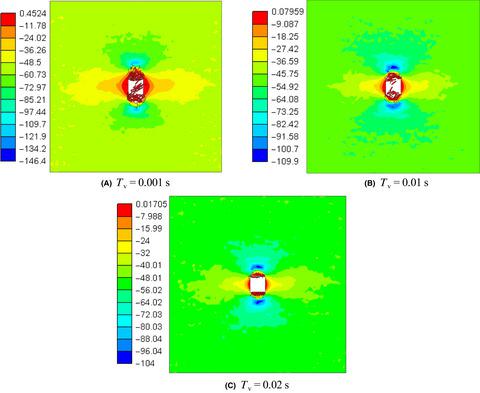当前位置:
X-MOL 学术
›
Energy Sci. Eng.
›
论文详情
Our official English website, www.x-mol.net, welcomes your
feedback! (Note: you will need to create a separate account there.)
Excavation unloading‐induced fracturing of hard rock containing different shapes of central holes affected by unloading rates and in situ stresses
Energy Science & Engineering ( IF 3.5 ) Pub Date : 2019-09-27 , DOI: 10.1002/ese3.486 Fan Feng 1 , Shaojie Chen 1 , Diyuan Li 2 , Wanpeng Huang 1 , Kang Peng 3 , Chuanwei Zang 1
Energy Science & Engineering ( IF 3.5 ) Pub Date : 2019-09-27 , DOI: 10.1002/ese3.486 Fan Feng 1 , Shaojie Chen 1 , Diyuan Li 2 , Wanpeng Huang 1 , Kang Peng 3 , Chuanwei Zang 1
Affiliation

|
Slabbing failure and strain rock burst are the main failure patterns during the excavation and construction phases of deep tunnels in hard and brittle rock, which cause unexpected equipment damage and casualties. This study presents a numerical simulation with an unloading central hole within a hard rock specimen in the laboratory scale. A combined finite element/discrete element method (FEM/DEM) reproduces the crack initiation, propagation, and coalescence around the central hole during the entire failure process. The influence of sectional shapes, unloading rates of holes, and in situ stresses on the failure characteristics and mechanical response of typical hard and brittle rocks were investigated by analysis of the failure pattern, displacement distribution (average velocity) of monitoring elements, and released strain energy value. The numerical results indicate that the sectional shapes, unloading rates, and in situ stresses have a significant impact on the severity of destruction and failure range in hard rock under the excavation unloading conditions. Slabbing failure (stable failure) is always the dominant failure pattern around a circular hole, which shows higher bearing capacities and self‐stabilization. With the increase in unloading rates, more visible cracks are generated around the holes, and the displacement and average velocity of discrete blocks are further raised. This is particularly evident in rock specimens with holes having vertical walls, leading to intense unstable failure (strain rock burst) accompanied by a large amount of strain energy released. In situ stresses affect considerably the stability of the surrounding rock during the excavation unloading process. With constant in situ stress, the order of destruction severity around the central hole according to its sectional shape is cube > trapezoid > U‐shape > ellipse > circle. The destruction intensity is further aggravated with the increase in lateral pressure coefficient, and the failure regions are always observed in the roof and floor of the central hole. This study confirms that strain rock burst tends to be induced in hard and brittle rock tunnels with polygonal roadway section under high unloading rates and lateral pressure coefficients.
中文翻译:

开挖卸荷导致的硬岩破裂受不同卸荷速率和原地应力影响的中心孔形状
在坚硬和脆性岩石的深层隧道的开挖和施工阶段,平板破坏和应变岩爆裂是主要的破坏方式,它们会导致意外的设备损坏和人员伤亡。这项研究提出了在实验室规模的硬岩标本中卸载中心孔的数值模拟。组合的有限元/离散元方法(FEM / DEM)在整个破坏过程中再现了中心孔周围的裂纹萌生,扩展和合并。通过分析破坏模式,监测元件的位移分布(平均速度)和释放的应变,研究了截面形状,孔的卸载速率和原位应力对典型的硬质和脆性岩石破坏特性和力学响应的影响。能量值。数值结果表明,在开挖卸载条件下,截面形状,卸荷率和原位应力对硬岩破坏和破坏范围的严重程度具有显着影响。扁板故障(稳定故障)始终是圆形孔周围的主要故障模式,显示出更高的承载能力和自稳性。随着卸荷率的增加,孔周围会产生更多可见的裂纹,离散块的位移和平均速度会进一步提高。这在带有垂直壁孔的岩石样本中尤为明显,这会导致剧烈的不稳定破坏(应变岩石破裂),并释放出大量的应变能。在开挖卸载过程中,原位应力会极大地影响围岩的稳定性。在恒定的原位应力下,中心孔周围的破坏强度根据其截面形状的顺序为立方>梯形> U型>椭圆>圆形。随着侧压力系数的增加,破坏强度进一步加剧,并且总是在中心孔的顶部和底部观察到破坏区域。这项研究证实,在高卸荷率和侧向压力系数的作用下,具有多角形断面的坚硬脆性隧道中容易引起应变岩爆裂。圆圈。随着侧压力系数的增加,破坏强度进一步加剧,并且总是在中心孔的顶部和底部观察到破坏区域。这项研究证实,在高卸荷率和侧向压力系数的作用下,具有多角形断面的坚硬脆性隧道中容易引起应变岩爆裂。圆圈。随着侧压力系数的增加,破坏强度进一步加剧,并且总是在中心孔的顶部和底部观察到破坏区域。这项研究证实,在高卸荷率和侧向压力系数的作用下,具有多角形断面的坚硬脆性隧道中容易引起应变岩爆裂。
更新日期:2019-09-27
中文翻译:

开挖卸荷导致的硬岩破裂受不同卸荷速率和原地应力影响的中心孔形状
在坚硬和脆性岩石的深层隧道的开挖和施工阶段,平板破坏和应变岩爆裂是主要的破坏方式,它们会导致意外的设备损坏和人员伤亡。这项研究提出了在实验室规模的硬岩标本中卸载中心孔的数值模拟。组合的有限元/离散元方法(FEM / DEM)在整个破坏过程中再现了中心孔周围的裂纹萌生,扩展和合并。通过分析破坏模式,监测元件的位移分布(平均速度)和释放的应变,研究了截面形状,孔的卸载速率和原位应力对典型的硬质和脆性岩石破坏特性和力学响应的影响。能量值。数值结果表明,在开挖卸载条件下,截面形状,卸荷率和原位应力对硬岩破坏和破坏范围的严重程度具有显着影响。扁板故障(稳定故障)始终是圆形孔周围的主要故障模式,显示出更高的承载能力和自稳性。随着卸荷率的增加,孔周围会产生更多可见的裂纹,离散块的位移和平均速度会进一步提高。这在带有垂直壁孔的岩石样本中尤为明显,这会导致剧烈的不稳定破坏(应变岩石破裂),并释放出大量的应变能。在开挖卸载过程中,原位应力会极大地影响围岩的稳定性。在恒定的原位应力下,中心孔周围的破坏强度根据其截面形状的顺序为立方>梯形> U型>椭圆>圆形。随着侧压力系数的增加,破坏强度进一步加剧,并且总是在中心孔的顶部和底部观察到破坏区域。这项研究证实,在高卸荷率和侧向压力系数的作用下,具有多角形断面的坚硬脆性隧道中容易引起应变岩爆裂。圆圈。随着侧压力系数的增加,破坏强度进一步加剧,并且总是在中心孔的顶部和底部观察到破坏区域。这项研究证实,在高卸荷率和侧向压力系数的作用下,具有多角形断面的坚硬脆性隧道中容易引起应变岩爆裂。圆圈。随着侧压力系数的增加,破坏强度进一步加剧,并且总是在中心孔的顶部和底部观察到破坏区域。这项研究证实,在高卸荷率和侧向压力系数的作用下,具有多角形断面的坚硬脆性隧道中容易引起应变岩爆裂。











































 京公网安备 11010802027423号
京公网安备 11010802027423号